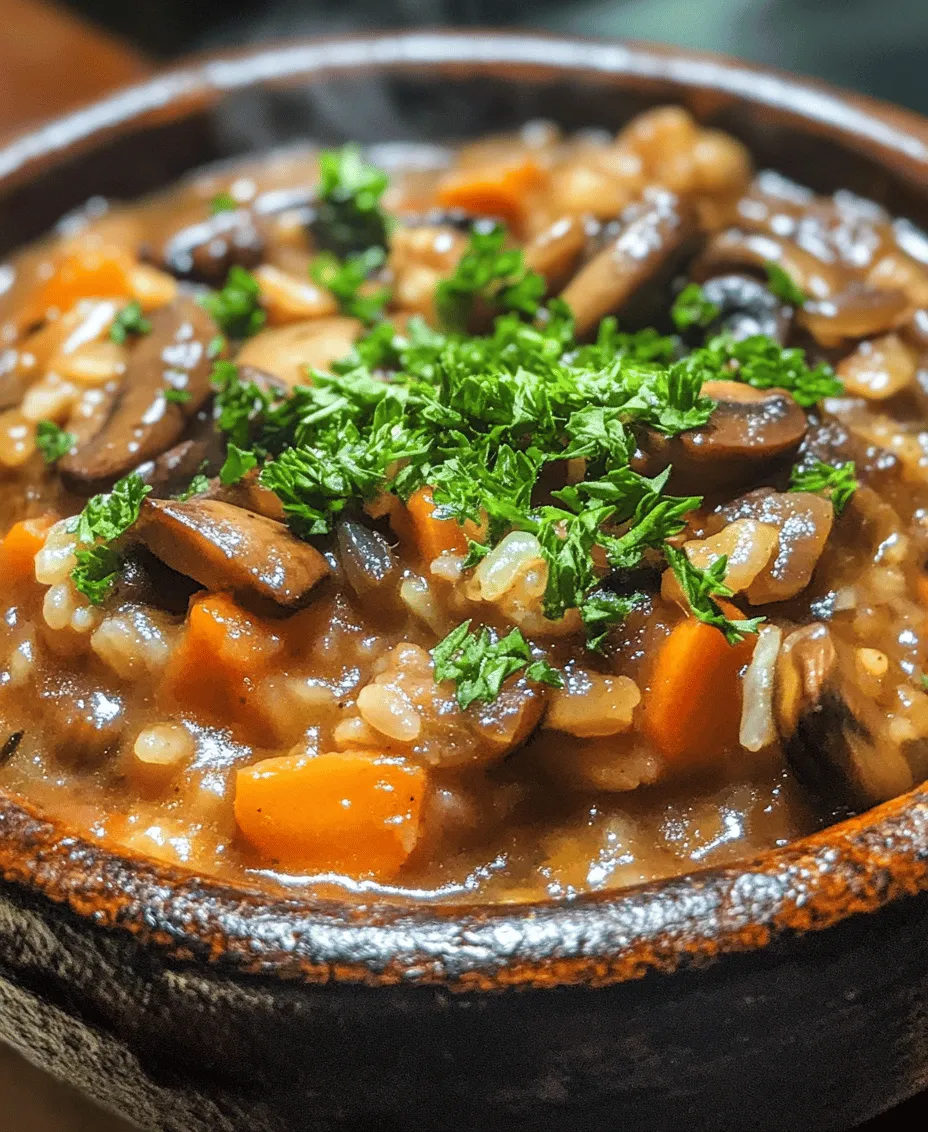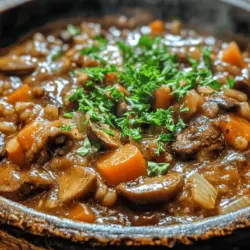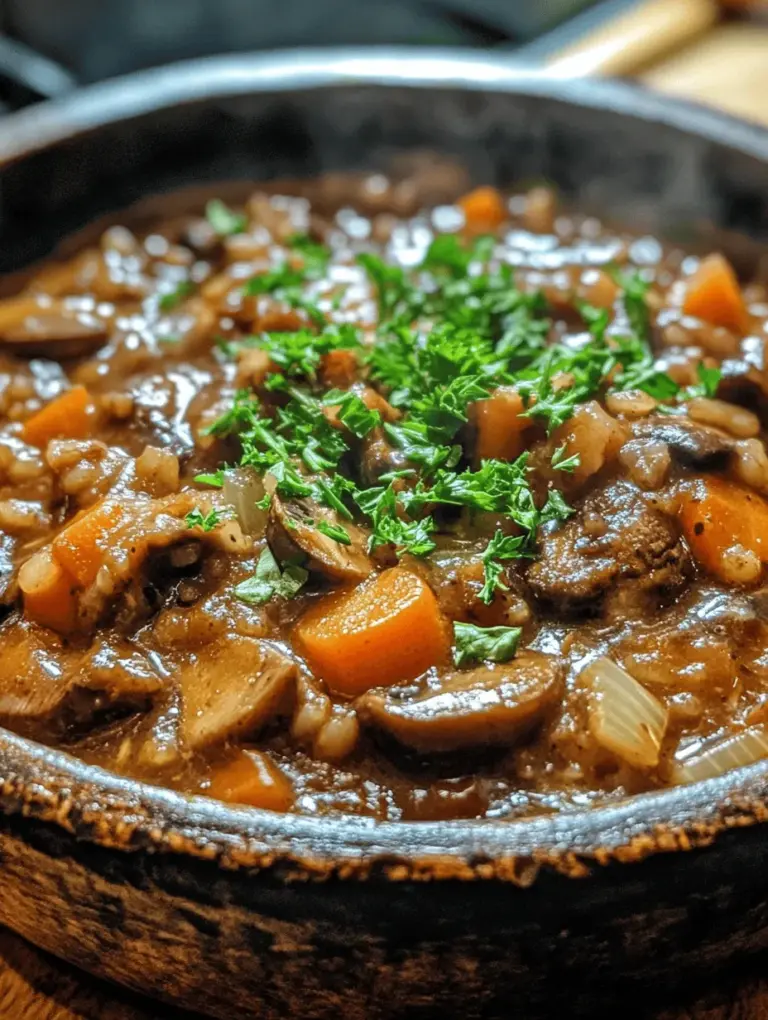As the temperature drops and the days grow shorter, there’s nothing quite like a warm bowl of soup to bring comfort and nourishment. Among the myriad of soup recipes, Hearty Wild Rice and Mushroom Soup stands out as a delightful choice, combining rich flavors and wholesome ingredients. This soup is not only satisfying but also brimming with nutrients, making it a perfect addition to your winter meal rotation.
The Comforting Nature of Hearty Wild Rice and Mushroom Soup
Wild rice, with its nutty flavor and chewy texture, serves as the backbone of this dish, while a medley of mushrooms elevates it to new heights of umami satisfaction. Together, they create a symphony of flavors that is both hearty and wholesome. Homemade soups like this one are especially treasured during colder months, as they provide warmth and comfort, turning simple ingredients into a nourishing meal.
Health Benefits of Wild Rice and Mushrooms
The Nutritional Power of Wild Rice
Wild rice is often celebrated for its impressive nutritional profile. Unlike its more commonly used cousins—white and brown rice—wild rice is actually a grain harvested from aquatic grasses and is often regarded as a superfood.
– Rich in Nutrients: Wild rice is packed with protein, making it a fantastic choice for vegetarians and those looking to incorporate more plant-based nutrients into their diets. A cup of cooked wild rice contains about 6.5 grams of protein, along with essential minerals like magnesium, phosphorus, and zinc.
– High in Fiber: This grain is also an excellent source of dietary fiber, which supports digestive health and helps maintain steady blood sugar levels. Just one serving provides nearly 3 grams of fiber, promoting a feeling of fullness that can aid in weight management.
– Antioxidants: Wild rice contains antioxidants that combat oxidative stress, potentially lowering the risk of chronic diseases.
Exploring Mushrooms: A Flavorful Addition
Mushrooms, particularly varieties like cremini, shiitake, and button mushrooms, bring not only depth of flavor but also numerous health benefits to the table.
– Variety of Flavors: Cremini mushrooms offer a slightly deeper flavor compared to the milder button mushrooms, while shiitake mushrooms add an earthy richness that enhances the soup’s overall taste.
– Health Benefits: Mushrooms are low in calories and fat, making them a great addition to any diet. They are a good source of B vitamins, selenium, and other nutrients. Additionally, certain types of mushrooms, like shiitake, are known for their immune-boosting properties.
– Rich in Umami: The natural umami flavors in mushrooms can enhance the overall taste profile of the soup, creating a savory experience that warms the soul.
The Role of Aromatics in Soup Making
No soup is complete without the aromatic foundation that onions and garlic provide. These two ingredients are essential for building flavor, adding complexity and depth to your dish.
– Onions: Sautéing onions until they become translucent releases their natural sweetness, creating a delicious base for the soup. The caramelization process enhances their flavor, making them a key player in any savory dish.
– Garlic: Similarly, garlic adds an aromatic punch that pairs beautifully with both wild rice and mushrooms. Cooking garlic until it’s fragrant—without letting it burn—ensures you get the best flavor without bitterness.
– Herbs: Fresh herbs, such as thyme and parsley, play a vital role in brightening the soup and adding freshness. Thyme, in particular, complements the earthiness of the mushrooms and wild rice, creating a harmonious blend of flavors.
Preparation Steps in Detail
Now that we understand the comforting nature of this soup and the health benefits of its ingredients, let’s delve into the preparation steps that will lead you to a delicious bowl of Hearty Wild Rice and Mushroom Soup.
Preparing Wild Rice: A Guide
The first step in preparing this soup is to properly prepare the wild rice. This may seem straightforward, but taking the time to rinse and cook the rice correctly sets the stage for a flavorful dish.
– Rinsing Wild Rice: Start by placing your wild rice in a fine-mesh strainer and rinsing it under cold running water. This step is crucial as it removes any residual dust or debris, ensuring that your rice is clean and ready for cooking.
– Cooking Process: Once rinsed, you’ll want to cook the wild rice. Begin by combining the rinsed wild rice with water or broth in a saucepan. The general rule of thumb is to use a 3:1 ratio of liquid to rice. Bring the mixture to a boil, then reduce the heat to low and cover. Allow the rice to simmer for about 45 to 60 minutes, or until it’s tender and has split open. The cooking time can vary slightly based on the specific brand of wild rice you use, so keep an eye on it.
Sautéing Aromatics: Building Flavor
While the wild rice cooks, it’s time to focus on the aromatics and vegetables that will form the base of your soup. Sautéing these ingredients properly is key to maximizing flavor.
– Techniques for Sautéing: In a large pot, heat a tablespoon of olive oil or butter over medium heat. Once hot, add chopped onions and sauté for about 5-7 minutes, or until they’re soft and translucent. This process releases their natural sweetness and forms the flavorful base for your soup.
– Perfectly Cooking Garlic: Once the onions are ready, add minced garlic to the pot. Sauté for an additional 1-2 minutes, stirring frequently to prevent the garlic from burning. Cook until fragrant, which typically takes about 30 seconds to a minute. The goal is to infuse the oil with garlic flavor without allowing it to turn bitter.
Cooking the Vegetables: Balancing Texture and Flavor
With the base of onions and garlic ready, it’s time to add in the mushrooms and other vegetables. The key here is to ensure that each vegetable retains its texture while absorbing the rich flavors of the soup.
– Adding Mushrooms: Slice your chosen mushrooms and add them to the pot. Allow them to cook down for about 5-8 minutes, stirring occasionally. You want the mushrooms to release their moisture and become tender.
– Incorporating Other Vegetables: After the mushrooms have softened, feel free to add additional vegetables such as carrots, celery, or spinach, depending on your preference. This not only enhances the nutrition of your soup but also adds layers of flavor and texture.
By carefully preparing each ingredient and ensuring that your aromatics are cooked to perfection, you set the stage for a richly flavored Hearty Wild Rice and Mushroom Soup that embodies comfort and nourishment. In the upcoming sections, we will explore the finishing touches and serve suggestions, ensuring that your soup is not only delicious but also a memorable centerpiece for your winter meals.

The Role of Each Vegetable in the Soup
The Hearty Wild Rice and Mushroom Soup is not just a dish; it’s a celebration of vegetables and their unique contributions to flavor and nutrition. Each ingredient plays a vital role in creating a balanced and satisfying experience.
1. Mushrooms: The star of the show, mushrooms add an earthy flavor and a meaty texture that gives the soup depth. Varieties like cremini, shiitake, or button mushrooms work well, each imparting its own unique taste profile.
2. Carrots: These vibrant vegetables bring sweetness and a pop of color to the soup. Carrots are also packed with beta-carotene, which the body converts into vitamin A, making them a nutritious addition.
3. Celery: Celery contributes a refreshing crunch and a subtle flavor base that enhances the overall taste of the soup. It’s rich in vitamins K and C, which support bone health and immune function.
4. Onions: Onions are fundamental in building the soup’s flavor foundation. They caramelize beautifully when sautéed, adding sweetness and richness. They also provide antioxidants that help combat inflammation.
5. Garlic: A few cloves of garlic add a pungent and aromatic flavor that complements the mushrooms and vegetables beautifully. Garlic is renowned for its health benefits, including boosting immunity and reducing blood pressure.
Tips on How to Sauté Vegetables to Enhance Their Flavors
Sautéing is a crucial technique in preparing the Hearty Wild Rice and Mushroom Soup. Proper sautéing can elevate the flavors of your vegetables significantly. Here are some tips to get it right:
– Use a Good Quality Oil: Start with a high smoke point oil, such as olive oil or avocado oil. This allows the vegetables to cook evenly without burning.
– Don’t Overcrowd the Pan: Sauté in batches if necessary. Overcrowding can cause the vegetables to steam rather than caramelize, resulting in a loss of flavor.
– Heat the Pan First: Preheating the pan ensures that the vegetables begin cooking immediately, promoting better browning.
– Season Early: Add a pinch of salt to the vegetables as they cook. This enhances their natural sweetness and aids in the release of moisture.
– Stir Occasionally: Give the veggies a stir every few minutes to ensure even cooking. You want them to become tender and caramelized without getting mushy.
Bringing It All Together: The Cooking Process
Adding Broth and Seasonings
Once your vegetables are perfectly sautéed and fragrant, it’s time to build the soup’s body. Start by adding your choice of vegetable broth. A good broth serves as the soup’s backbone, providing moisture and flavor.
– Choosing the Right Vegetable Broth: When selecting vegetable broth, opt for low-sodium options, as this allows you to control the saltiness of your soup. Homemade vegetable broth can be even more flavorful and tailored to your taste.
– Importance of Herbs: Fresh or dried herbs can transform your soup. Thyme and rosemary are classic choices that complement the earthy flavors of wild rice and mushrooms. Adding a bay leaf during cooking infuses an aromatic depth that enhances the overall profile.
Finishing Touches: Coconut Milk vs. Heavy Cream
Choosing between coconut milk and heavy cream alters the texture and flavor of your soup significantly.
– Flavor Differences and Dietary Considerations: Coconut milk offers a rich, slightly sweet creaminess that pairs well with the earthy notes of the soup, making it an excellent choice for vegan diets. Heavy cream brings a luxurious, velvety texture and a more neutral flavor, perfect for those seeking a richer experience.
– How to Incorporate and Adjust Creaminess: If you choose coconut milk, add it towards the end of cooking. Start with one cup and add more if you prefer a creamier texture. For heavy cream, stir it in after removing the soup from heat to avoid curdling.
Serving Suggestions
Ideal Pairings for Wild Rice and Mushroom Soup
This soup is hearty enough to stand alone but pairs wonderfully with various sides that enhance the dining experience.
– Recommended Bread or Side Dishes: A slice of rustic sourdough or a warm baguette is perfect for dipping. Alternatively, a fresh side salad with a light vinaigrette adds a refreshing contrast.
– Suggested Wine or Beverage Pairings: A crisp white wine, such as Sauvignon Blanc, pairs beautifully with the earthy flavors of the soup. For non-alcoholic options, a sparkling water with a twist of lemon or herbal tea can complement the meal.
Garnishing for Presentation
A beautiful presentation can elevate your soup. Here are some garnishing ideas:
– Importance of Fresh Parsley as a Garnish: A sprinkle of fresh parsley not only brightens the dish visually but also adds a hint of freshness that balances the rich flavors.
– Other Possible Toppings to Enhance the Dish: Consider topping your soup with sautéed mushrooms, a drizzle of truffle oil, or a sprinkle of grated parmesan cheese for added depth and richness.
Nutritional Information
This Hearty Wild Rice and Mushroom Soup is not just delicious; it’s packed with nutrients. Here’s a breakdown of the nutritional aspects:
– Calories: Approximately 250 calories per serving, depending on the ingredients used.
– Macronutrients: Each serving typically contains around 8 grams of protein, 12 grams of fat (if using coconut milk), and 40 grams of carbohydrates, making it a balanced option.
– Vitamins and Minerals: The soup is an excellent source of vitamins A, C, and K, as well as essential minerals like potassium and magnesium.
Health Benefits of Each Main Ingredient
– Wild Rice: High in fiber and protein, wild rice is a whole grain that supports digestive health and provides sustained energy.
– Mushrooms: Rich in antioxidants, mushrooms can boost immune function and reduce inflammation.
– Vegetables: The combination of carrots, celery, and onions contributes essential vitamins and minerals while being low in calories, making this soup a nutrient-dense choice.
Dietary Considerations
This soup is versatile and can cater to various dietary needs:
– Vegan: By using vegetable broth and coconut milk, the recipe can easily fit a vegan diet.
– Gluten-Free: Wild rice is naturally gluten-free, ensuring that this soup is safe for those with gluten sensitivities.
Conclusion
The Hearty Wild Rice and Mushroom Soup is more than just a meal; it’s a comforting hug in a bowl that brings warmth and nourishment to any occasion. Packed with wholesome ingredients and rich in flavor, this recipe is perfect for chilly evenings or when you need a cozy pick-me-up.
We encourage you to try this recipe at home, reveling in the joy of creating a homemade soup that not only fills your belly but also warms your heart. Homemade soups like this one are versatile and can be adjusted to suit your taste preferences or dietary needs, making them a staple in any kitchen, no matter the season. Embrace the comfort of cooking and the satisfaction of enjoying a nutritious, delicious meal with your loved ones.

